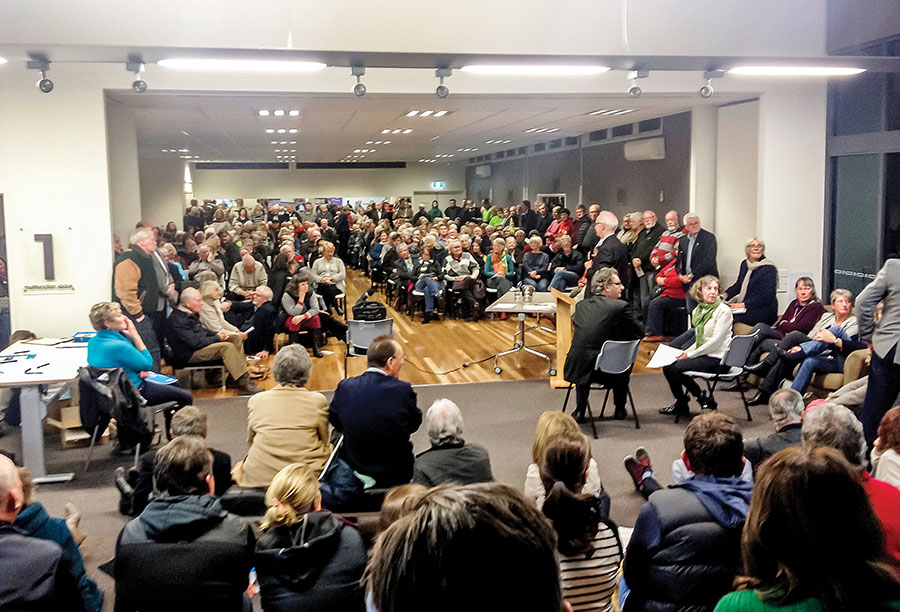
THE state Labor government’s planning department has no interest in protecting the Mornington Peninsula from overdevelopment, says RMIT planning specialist Professor Michael Buxton.
Peninsula residents will have to fight hard to protect the shire from overdevelopment and will have to involve themselves in the future governance of the region as well as put electoral pressure on the government, he told a meeting of more than 300 residents at Hastings last Thursday night.
The meeting had been called to explain recent changes in state government planning laws that will allow developers to build three-storey houses up to 11 metres high in 10 towns on the Mornington Peninsula – Capel Sound (formerly Rosebud West), Rosebud, Dromana, parts of Mt Martha, Mornington, Baxter, Somerville, Tyabb, Hastings and Bittern.
Developments can occur with no notifications and no rights of appeal. The first thing many neighbours will know about a development is when builders show up one day at 7am.
Professor Buxton said the government “has a loathing of height controls” and residents and the shire council will have to join forces to oppose planning changes that favour the development industry.
He said Victoria had benefited from the long-term vision of state Liberal Premier Dick Hamer and his planning minister Alan Hunt (father of Flinders MP Greg Hunt) when they introduced planning schemes in the 1970s for high value agricultural regions such as the Mornington Peninsula as well as Upper Yarra Valley, Dandenong Ranges and Macedon ranges.
The Mornington Peninsula Planning Scheme put an end to a proposal for a new suburb for 40,000 people on the Moorooduc Plains between Mornington and Somerville, and protected green wedge-type areas from subdivision.
Professor Buxton said the scheme had protected the peninsula well but now was another critical time with developers eyeing off the region.
In March, the state government amended all Victorian planning schemes and implemented significant changes to zones, including the General Residential Zone, which applies to most built-up parts of the peninsula.
Plan Melbourne 2017-2050 allows for houses of up to 11 metres and three-storeys in the GRZ with no notification and no right of appeal.
Professor Buxton criticised recent attempts to allow tourism accommodation to be built in green wedge zones including on the peninsula. “Big standalone tourism complexes provide little benefit to existing towns,” he said. “Developers and operators want to keep guests on site and extract every dollar from them.”
He called for stronger state planning policy to protect the peninsula and its scenic landscapes. “The peninsula could be declared a food bowl region. Its unique towns should be protected. Put a line around rural areas and say hands off.
“The peninsula is an area of international significance with world-scale landscape values, biodiversity, beautiful coastlines, and vibrant communities.”
Professor Buxton warned the Labor government intended to privatise the entire planning system, and a tender had been let to rewrite all documentation.
“This is a new idea designed to shut residents out of planning matters, and move development applications into a category where no permits are required,” he said. Construction of medium-density housing and apartments would be approved without any advertising.
He said beware of claims about getting rid of red tape: “This is a cover for giving planning to the development industry.”
Professor Buxton urged residents to “like Hamer and Hunt, look forward 50 years and even 100 years” and promote the core belief of protecting the peninsula.
Cr David Gill said that “for 40 years we have had bipartisan political agreement that the peninsula is unique and should not be treated with one-size-fits-all suburban planning regulations”.
“Our peninsula has been mainly protected from the Melbourne sprawl and the worst kinds of development. This requires localised protections built into our planning scheme,” he said.
“It is very doubtful that planning minister Richard Wynne will allow the shire to change to a neighbourhood residential zone that allows more protections including height controls, limiting houses to two storeys.”
He said the shire would attempt to introduce an interim design and development overlay (DDO) to stop three-storey houses. “However our planning overlays can be removed by the minister.
“All of this puts in doubt the shire’s wish to adopt enhanced green wedge zone regulations preventing unacceptable development in rural areas.
“It looks like the peninsula is being softened up for the powerful development lobby to undermine the 40-year politically bipartisan protections built into the planning scheme in order to properly plan the future of our region.”
Christine Haydon of Peninsula Speaks told the meeting a petition was being organised and a community committee would be formed to coordinate opposition.
To register for more information, email: info@peninsulaspeaks.org.au
First published in the Southern Peninsula News – 27 June 2017